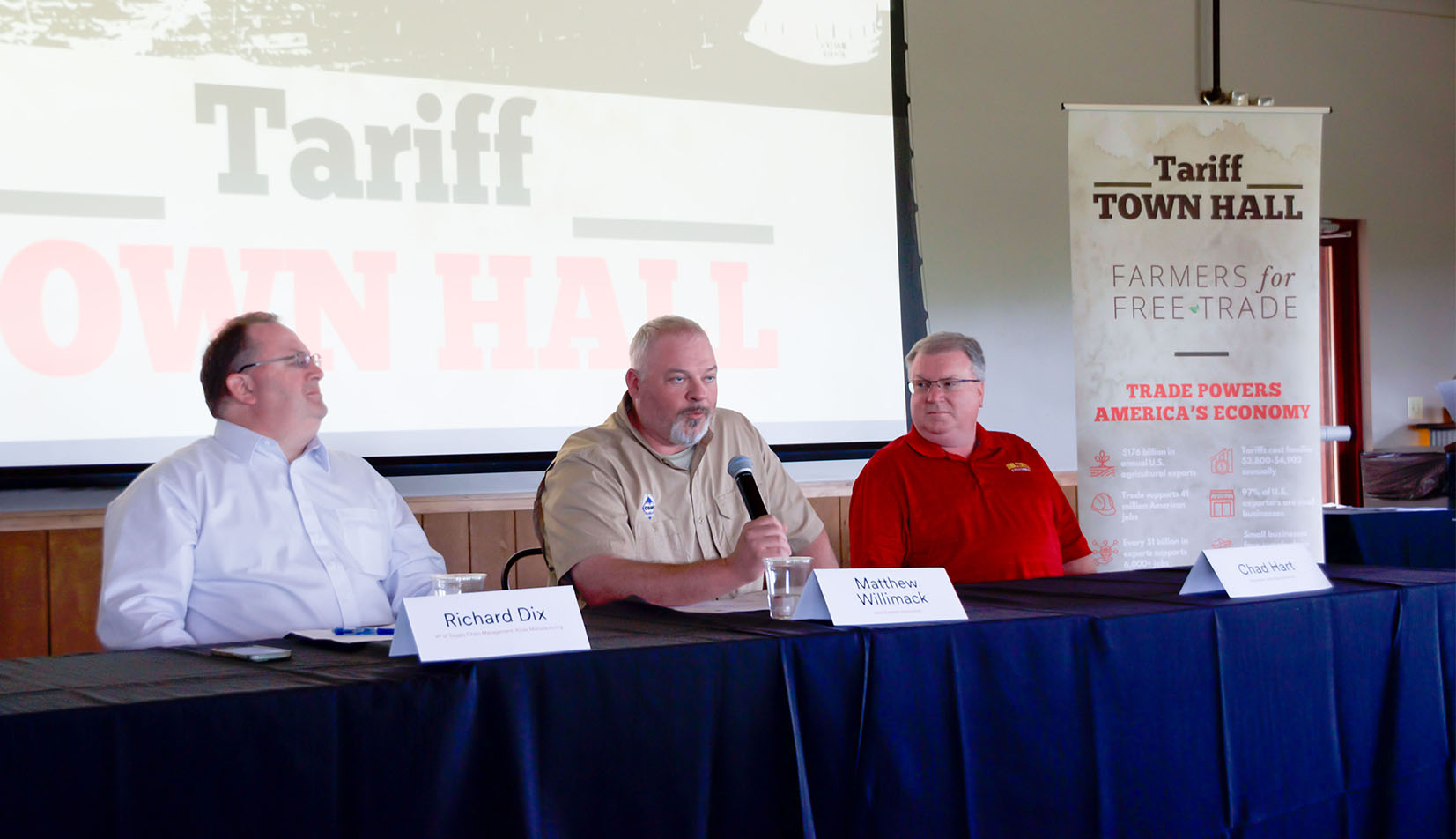
(Photo: Iowa Soybean Association / Bethany Baratta)
Tariffs triple, Iowa industries discuss impacts
June 26, 2025 | Bethany Baratta
In April 2025, U.S. importers paid $20 billion in tariffs, more than three times the amount paid in April 2024. Of the April 2025 tariffs, $17 billion stemmed from executive actions, including Section 301, Section 232 and International Emergency Economic Powers Act, compared to about $3 billion one year earlier, according to data compiled by Trade Partnership Worldwide, LLC, an international trade and economic research firm.
Iowa companies and consumers have paid $68 million more from April 2024 to April 2025 to get products into Iowa, according to the data. The 304% increase comes with an impact to farmers, manufacturers, distillers and those who live and work in the state. During a recent town hall hosted by Farmers for Free Trade, those impacted spoke about what they’re seeing in their respective industries.
Matthew Willimack, Iowa Soybean Association District 6 director and farmer near DeWitt
Farmers are feeling the impacts of the tariffs on both sides, says Willimack.
"We buy our inputs — some of those are coming from other countries — fertilizers, chemicals — so we pay the tariff coming in. But there are products that we produce — corn and soybeans … and we get a tariff on the way out."
How’s the soybean market right now?
"It's hard to try to manufacture profitability out of the soybean acre today," Willimack says.
Additionally, Brazil, the United States' biggest soy-producing competitor, has the ability to expand acreage.
"So, by engaging in trade disputes with China, we're taking away our largest costumer (China) and handing it over to somebody else (Brazil)."
Chad Hart, economist, Iowa State University
There's essentially a 10% tariff curve across the board for most of the imports coming into the United States. Additionally, there are reciprocal tariffs compounded by specific tariffs hitting industries like steel and aluminum.
This leads to business and consumer confusion, Hart says.
The trade and tariff landscape changes day-to-day, so keeping up with the retaliatory efforts and who the U.S. might be in trade talks with changes often.
"What we don't have is a good indication about which of those tariffs would be there and which ones have been negotiated away," Hart says. "And therefore, how can the economy respond to those tariffs?"
What's been the impact on agriculture?
"Soybean and pork are the most impacted right now because those two commodities are much more reliant on China, and China is the one where we've seen the largest tariffs being put in place here within the U.S. China has been one of the mostly boldly responding with tariffs of their own," he says.
Nearly 40% of the soybeans produced in the U.S. are exported; 20% of that has ended up in China over the past decade.
“They have been by far our largest market for soybeans, so it has a major impact on soybeans."
Richard Dix, vice president of supply chain management for Kinze Manufacturing
Kinze is a highly integrated manufacturer of large equipment, and it doesn't make the company immune to tit-for-tat tariffs, says Dix.
"We source a significant amount of our material here in the United States, but also a sizable percentage internationally. Even the items we buy here in the U.S. typically have some form of foreign component that's built in. So, we have to really go down past the first tier of our supply chain, even the second tier."
The coming and going of tariffs in recent years has made it difficult for dealers and customers, too.
"If you had bought a planter a couple of months ago, you may have anticipated much higher tariffs than what you have today. But even that was more than before … what's the dealer to do? Do they invest in that equipment when they think it might be at the peak? Or do they wait a little bit? That confusion adds to indecision," Dix says.
Jeff Quint, CEO of Cedar Ridge Distillery
Since bourbon is protected under international treaties and can only be made in the United States, it's always on the “short list” when it comes to retaliatory efforts from other countries.
Take Canada, for example. The liquor stores in Canada are government controlled, and they've pulled all the American whiskey (including bourbon) off the shelves.
"So, we're dead in the water in Canada right now because of the negotiations that are going on," Quint says.
It's akin to the tariffs in 2018, when the European Union slapped tariffs on bourbon, he says.
"We haven't bothered to go back to the EU," Quint says. "It takes a number of years to build up a business in a foreign country. You don't just walk in there and start making money. It’s an investment, and we're not willing to make those kinds of investments right now because of the uncertainty around tariffs and the fact that bourbon is the first thing they seem to want to tariff all the time."
Cedar Ridge's bourbon is sold in 35 states, including Iowa, and was sold in the EU, Canada, Japan and Australia prior to the tariffs.
"Japan and Australia are the only places we're shipping to; we're not looking at any other markets right now because of the situation," Quint says.
Written by Bethany Baratta.
Back